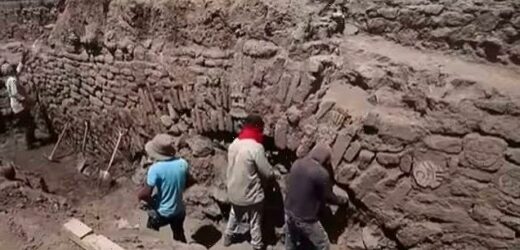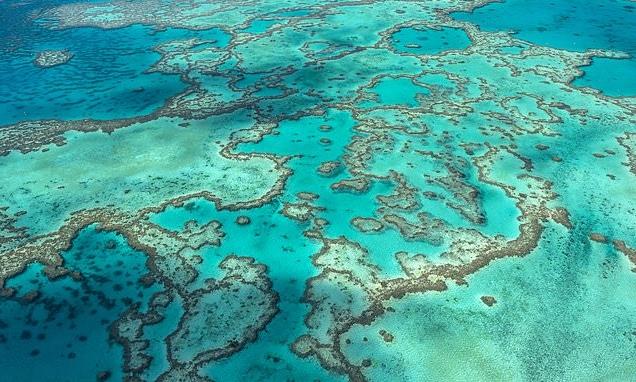Mexico will RE-BURY an Aztec tunnel adorned with carvings and paintings that was built by Emperor Montezuma 600 years ago because it can’t afford to build a display amid COVID crisis
- Workers stumbled upon the 15th century tunnel in 2019 while digging a bus stop outside Mexico City
- The passageway combined colonial Spanish and pre-Hispanic features
- It is associated with Tlaloc, the Aztec god of water and fertility
- Experts found statues, carving and inscriptions throughout the tunnel
- But plans for a public display have been scotched as pandemic saps funding
The cost of dealing with the coronavirus pandemic has forced Mexican archaeologists to re-bury an ancient passageway that combined colonial and pre-Hispanic features.
In 2019, the National Institute of Anthropology and History announced it found a flood-control tunnel on the outskirts of Mexico City that had Spanish construction techniques but Aztec symbols carved into it.
The institute planned to make an exhibit of the strange tunnel, built in the early 1600s to replace an earlier Aztec flood-control system built in the 1400s to protect Mexico City, then an island surrounded by shallow lakes, against periodic floods.
On Thursday, the institute announced archaeologists would simply cover the finds with dirt again, in hopes that someday it would have enough funds to build a display.
‘The world-wide COVID-19 health emergency forced all levels of government to place priority on assigning money to health care for the population,’ the institute said in a statement.
‘For that reason, the archaeological project had to be postponed.’
In 2019, archaeologists unearthed a secret Aztec tunnel chamber hiding under Mexico City for more than 600 years. But the costs associated with combating the pandemic have forced them to re-bury the find rather than construct a public display
Mexico has had to expand its hospital system and buy vaccines and medicines to cope with the pandemic, which has resulted in some 237,626 confirmed deaths.
But because officials have not wanted to buy large numbers of tests, many people have died without being tested, and the real death toll is believed to be around 360,000.
The tunnel was discovered in 2019 in an ancient flood-control wall during the construction of a bus stop.
Experts speculate the pre-Hispanic symbols may have been placed by Indigenous laborers who were the main workforce during its construction.
The hidden tunnel was found in Ecatepec de Morelos in Mexico City
The site in which the wall was found is part of a more than decade long conservation project around la Calzada de San Cristobal
Carved pre-Hispanic stones were sometimes used in colonial-era churches and houses, in part because the Spanish used rubble from demolished Indigenous structures as building material.
But the Aztec stones found in the tunnel appeared to be prominently and intentionally displayed.
Adorned with carvings and paintings, the passageway is believed to have been ordered built by Emperor Montezuma I and was associated with Tlaloc, the Aztec god of water and fertility.
Although Tlaloc was seen as a giver of life, Aztecs also feared him because they believed he sent down hail and lightning and had the ability to poison their water sources.
Discovery of the wall was part of a more than decade-long conservation project around la Calzada de San Cristobal.
This tunnel was believed to have been built by the famed Aztec Empire Moctezuma I who is said to have brought social, economic and political reform to strengthen Aztec rule. Piece of statues were found inside of the tunnel such as feet and a decapitated seated figure
The National Institute of Anthropology and History hopes to one day uncover the tunnel again and build a proper public display for it
Montezuma, or Moctezuma, was the second Aztec emperor, ruling from about 1440 to 1469.
He was followed by Moctezuma II, the emperor who confronted — and ultimately succumbed to — Spanish conquistadors led by Hernan Cortes.
The Aztecs were renowned for their agriculture— draining swamps, introducing irrigation, and creating artificial islands in the nearby lakes.
Their civilization also developed a form of hieroglyphic writing, a complex calendar system and built famous pyramids and temples.
Aztecs were famous for their agriculture, introducing irrigation, draining swamps, creating artificial islands in the lakes and building intricate structures like
The tunnel was first discovered by labor workers who were digging in the area in order to build a bus stop. The tunnel is more than 600 years old and was built by Aztecs
But they were also known for ritual sacrifice and cannibalism: In May 2019, archaeologists discovered the remains of more than 450 people at the ancient Zultepec-Tecoaque site in modern day Mexico City.
Experts say the victims were kept prisoner for six months, fed and then used in sacrifices reenacting scenes from mythology.
The sacrifices were members of a Spanish convoy from Cuba who reached Aztec territory in 1520, laden with supplies for Cortes.
But they met a grisly end at the hands of their Aztec captors, who held them prisoner in doorless cells where they were ‘fattened up’ for sacrifice.
Over the next six months the town ate the prisoners — including toddlers and pregnant women, whose heads were strung up on skull racks alongside their men.
Adorning the 27.5-foot long wall are 11 carved images, as well as what was once a wooden gate. Other items found inside include artifacts made of glass, porcelain, majolica
The tunnel is part of a 15-year project that is unearthing a massive structure in the area built hundreds of yeas ago
Archaeologists founds carvings around the tunnel, which suggest it was built in the 15th century
Just a year later, Spanish colonists conquered the Aztec empire and toppled its capital city, Tenochtitlan.
After the Spanish took Tenochtitlan in 1521, they destroyed parts of the pre-Hispanic aqueducts—and today Mexico City is in danger of sinking into its now-dry lake beds.
WHO WERE THE AZTECS AND WHAT DO WE KNOW ABOUT THEM?
The Mexica, later known as the Aztecs, were a migrant people from the desert north who arrived in Mesoamerica in the 1300s.
This previously nomadic tribe was not welcomed by the local inhabitants who viewed them as inferior and undeveloped.
Legend says that, as a result the Aztecs, wandered waiting for a sign to indicate where they should settle.
In 1325 AD this sign, an eagle and serpent fighting on a cactus, was seen at Lake Texcoco – prompting the Aztecs to found their capital city, Tenochtitlan.
By 1430 AD the Aztecs had assimilated aspects of the surrounding tribes and developed into a structured society.
Their military became powerful and campaigns were fought and won.
The Triple Alliance was created with the lords of Texcoco – situated on the eastern shores of Lake Texococo – and Tlacopan – sometimes referred to as Tacuba, situated on the western shores of Lake Texococo – further strengthening Aztec power.
The Aztecs went to war for two main reasons; to exact tribute and to capture prisoners.
They needed prisoners because they believed that the gods must be appeased with human blood and hearts to ensure the sun rose each day.
Conquering new regions brought the opportunity to capture slaves who were an important part of Aztec society.
Prosperity and unity within the Aztec peoples brought confidence. Under a succession of rulers armies were sent further across Mexico.
By the start of the 1500s the Aztec empire stretched from the Atlantic to the Pacific and into Guatemala and Nicaragua.
The arrival in 1521 AD of Hernan Cortés with Spanish soldiers brought about the end of the empire.
Source: The British Museum
Source: Read Full Article











